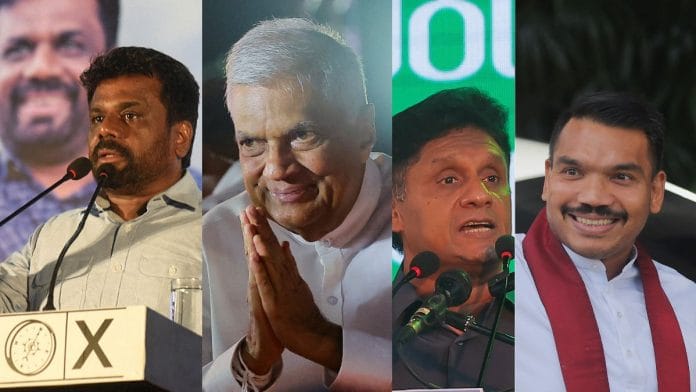Colombo: Sri Lanka goes to the polls Saturday for the first time since the 2022 economic crisis. The incredibly decisive presidential election is a close race between three candidates, reflective of the political chaos and popular uprising the economic crisis plunged the island country into.
Many say that the presidential elections in Sri Lanka, which has a powerful executive presidency, is like picking the captain of a team, while the parliamentary elections—slated for 2025—will pick its players.
There’s a lot at stake for the 22 million Sri Lankans—around 17 million are eligible to vote, and 38 presidential candidates are in the fray. And for the first time in Sri Lankan history, the country might have to go for a second round of counting, because it looks like there’s no clear winner.
In an extremely unpredictable race, there are four major candidates in a largely tripartite contest.
Incumbent President Ranil Wickremesinghe is running as an independent, and the leader of the opposition, Sajith Premadasa, as an Samagi Jana Balawegaya (SJB) candidate.
Anura Kumara Dissanayake, leader of the Marxist JVP at the helm of the coalition National People’s Power, is a wild card candidate and anecdotally the most popular, campaigning on an anti-corruption platform that promises the “system change” that the 2022 popular uprising, the aragalaya, demanded.
The fourth candidate is Namal Rajapaksa, scion of the Rajapaksa family, son of former prime minister Mahinda Rajapaksa and nephew of former president Gotabaya Rajapaksa—the man who became the main villain of the aragalaya and was eventually ousted and forced to flee.
While Rajapaksa isn’t polling highly, his family’s popularity and large voter base could create issues when it comes to the second round of counting of votes.
It’s a political situation that the country, which has typically seen presidential races between two strong candidates, has never faced—perhaps because of the political havoc that the 2022 crisis created.
“The politics of Sri Lanka broke down with its economy,” Ranil Wickremesinghe told ThePrint. “The system is [already] changing.”
A complicated poll process
The counting of ballots in Sri Lanka is a complicated process, because the voter will have to rank up to three candidates in order of preference on the ballot paper.
If one of the candidates has a clear majority of over 50 percent, that person is declared the winner of the presidential election.
However, if nobody gets a clear majority, which looks like an inevitability, then votes will have to be counted in a second round.
If nobody gets an absolute majority, then everyone except the top two candidates will be eliminated.
And this is where it gets interesting: a run-off vote isn’t conducted between these top two candidates. Instead, the second preference of voters who didn’t vote for the top two candidates is recorded.
If this second preference is given to the first or second candidate, then those votes are added to their tally. If the second preference is given to a candidate who is not first or second, then the third preference on that ballot paper is recorded.
This is why Namal Rajapaksa’s fourth place role makes the three-part race difficult: he has a loyal voter base whose ballots will definitely come into play because he’s currently unlikely to be in the top two candidates.
There are no reliable polls in Sri Lanka that indicate who’s in the lead, while all three top candidates seem confident of their success.
Usually, the top two candidates get the maximum votes—in the last presidential elections in 2019, Gotabaya Rajapaksa got 52 percent and Sajith Premadasa got 42 percent. The third candidate, Anura Kumara Dissanayake, who seems to be vying for the top in this election, got only 3 percent.
The fourth-place candidate in the 2019 elections got less than 50,000 votes. But this time, it looks like the fourth-place candidate, which in all likelihood is Namal Rajapaksa, is expected to get at least a million votes, which shows how tight the race will be.
In the random off-chance that there’s a tie between two candidates, then it’s up to the Election Commission to decide the winner by drawing lots.
However, the law doesn’t specify exactly how the lots will be drawn—so it could be through drawing straws, picking chits out of a hat, or even a coin toss.
Voting will begin at 7am Saturday at 13,134 polling stations across the country. Polls will close at 4pm, and counting is expected to start later that night. The results of the first count should be clear by noon Sunday.
(Edited by Nida Fatima Siddiqui)
Also Read: As Sri Lanka prepares for 1st presidential polls since economic meltdown, a look at what’s at stake






